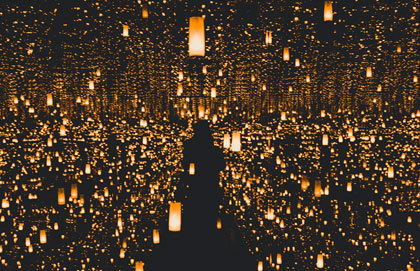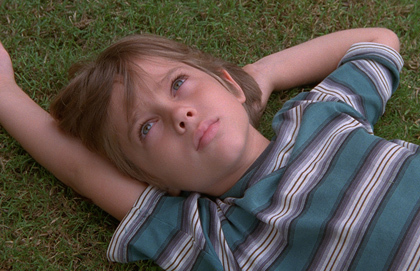Did you know there are over 35 adjectives in English just to describe light? It can be coruscating or crepuscular, glistening or glaring, prismatic or penumbral. Oddly enough, though, light itself is not something we see; we see its reflections and refractions, we see through it to the objects it illuminates. Yet the ineluctable modality of the visual depends upon such paradox.
There is something endlessly fascinating about light. In a stunningly beautiful short film, Flickering Lights, Joseph Gordon-Levitt invites viewers to become participants in a collage of moments where the subtle play of light both arrests and moves the viewer. Being arrested and moved, being "still and still moving," is arguably the effect that good art initiates; yet it also leaves us another paradox.
In Gordon-Levitt's film, the poet Wirrow's description of light as "bits of foil in the distance / blowing kisses from the sun to me" reminded me of Gerard Manley Hopkins' lines: "The world is charged with the grandeur of God. / It will flame out, like shining from shook foil."
Yet while Wirrow invites a movement of our imaginations to the sun as the visible source of light, Hopkins invites us to another sort of movement, one which goes beyond the limits of the visible.
This weekend marked the Winter Solstice: the dying of the light, the dead of winter, the covering of earth in forgetful snow. And I love that in the face of historical accuracy, the Church chose this symbolic time of year to appropriate Roman sun festivals by celebrating the entrance of Christ into the world.
While you might expect the weight of such glory to shake the earth, it (in another paradox) largely escapes notice. In my favourite of the gospel accounts, the Apostle John writes: "The true light that gives light to everyone was coming into the world. He was in the world, and though the world was made through him, the world did not recognize him."
In many ways, the incarnation we celebrate this month is just a series of impossible paradoxes. Yet as G.K. Chesterton said, "Paradox is the ally of Truth. The good news of the Christian Gospel is that God who is Spirit became flesh, infinite being became finite existence, the immortal One became mortal man in order that death might be undone and humanity might be drawn up into spiritual life."
Yet how did (and does) such a profound penetration of the transcendent light into the sin-darkened world go by unnoticed?
As the prophets said, people have eyes, but don't see, ears but don't hear. Perhaps the ineluctable modalities of the visual and the audible are simply not enough. Perhaps, if we are to see the invisible, we also have to allow for the ineluctable modality of belief.
This Christmas season, I want to try to pay attention to the subtle beginnings of the almost imperceptible lengthening of days and the increasing life and light they bring. I want to see the myriad of flickering lights around me and see to what they point. I want to say with T.S. Eliot:
We thank Thee for the lights that we have kindled,
The light of altar and of sanctuary,
Small lights of those meditate at midnight
And lights directed through the coloured panes of windows
And light reflected from the polished stone,
The gilded carven wood, the coloured fresco.
Our gaze is submarine, our eyes look upward
And see the light that fractures through unquiet water.
We see the light but see not whence it comes.
Light. Light.
Visible reminder of Invisible Light.







